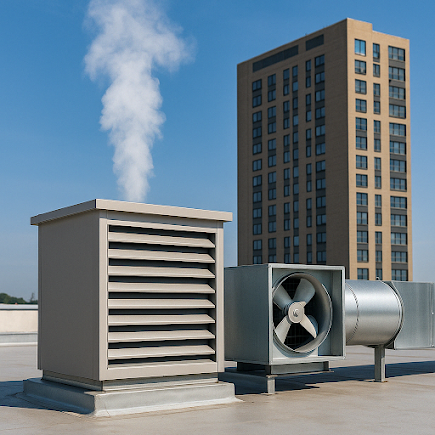High-rise buildings are architectural marvels — but when it comes to fire safety, they come with serious risks. One of the greatest threats during a fire isn’t just the flames — it’s the toxic smoke that rapidly fills corridors, stairwells, and lifts.
Without an effective smoke control system, evacuation becomes extremely dangerous, and firefighting efforts are hindered. That’s where smoke ventilation systems, AOVs, and mechanical extract solutions become critical — especially in multi-storey properties.
In this article, we’ll explore the unique challenges high-rise buildings face and the life-saving solutions that can make all the difference.
Why Smoke Rises: The Chimney Effect
During a fire, hot smoke rises quickly. In high-rise buildings, this creates what's known as the “chimney effect” — where smoke shoots upward through stairwells, lift shafts, and service risers.
This effect is amplified by:
-
The height of the building
-
Stack pressure caused by temperature differences
-
Natural convection
As a result, upper floors can become engulfed in smoke within minutes, even if the fire starts much lower down. This makes smoke ventilation systems essential for creating safe escape routes and supporting emergency services.
UK Legal Requirements for Smoke Ventilation in Tall Buildings
High-rise buildings are subject to strict UK fire safety regulations. Key standards include:
-
Approved Document B – Part of Building Regulations, it outlines requirements for smoke control in stairwells and lobbies.
-
BS EN 12101 – Sets the standard for smoke and heat control systems.
-
BS 9999 – Covers fire safety strategies in buildings.
-
Regulatory Reform (Fire Safety) Order 2005 – Makes it the duty of the ‘Responsible Person’ to maintain safe escape routes.
Failure to comply can lead to prosecution, building closure, and severe safety risks in the event of fire.
Common Challenges in High-Rise Smoke Ventilation
1. Limited Ventilation Routes
Older or compact towers often have fewer windows, ducts, or natural ventilation paths. Creating an effective airflow strategy can be tricky.
2. Power Dependency
Mechanical systems need electricity. In a fire, power failures are common, making emergency backups and system resilience essential.
3. Difficult Maintenance Access
Equipment installed on rooftops or in cramped risers can be hard to access. Regular servicing is still vital — even if the system is difficult to reach.
4. High Occupancy, Small Escape Routes
With hundreds of residents or workers, escape routes get congested fast. Smoke ventilation must keep those areas clear and breathable.
Smart Smoke Ventilation Solutions for High-Rise Buildings
🔹 Automatic Opening Vents (AOVs)
These open automatically when triggered by fire alarms or smoke detectors. AOVs are commonly installed in:
-
Stairwells
-
Communal lobbies
-
Escape corridors
They allow smoke to rise and exit the building — helping occupants evacuate safely and firefighters access upper floors.
🔹 Mechanical Extract Systems
These are powered systems that actively pull smoke out using fans and ductwork. Ideal for:
-
Deep-plan buildings
-
Underground car parks
-
Buildings with limited natural ventilation
They work with AOVs to create a hybrid system, balancing passive and active airflow control.
🔹 Smoke & Fire Dampers
Installed within ductwork, dampers automatically open or close based on fire or smoke conditions. They:
-
Prevent the spread of smoke between zones
-
Direct smoke toward extract routes
-
Shut off airflow when needed for containment
Real-World Example: Success Through System Design
At FTG Ltd, we recently worked on a 16-storey residential tower in the South East. The client needed a compliant, cost-effective solution with minimal disruption to residents.
We installed:
-
AOVs in all stairwells and corridors
-
Mechanical extract system on the rooftop
-
Fire dampers in shared duct routes
-
Emergency backup power integration
The system was fully commissioned and passed regulatory testing — giving the client confidence in both performance and compliance.
Ongoing Maintenance: The Safety Net That Saves Lives
Installing a smoke ventilation system is only half the job. Without regular maintenance, even the best systems can fail.
At FTG Ltd, our ongoing service contracts include:
-
Annual testing and re-commissioning
-
24/7 emergency callouts
-
Compliance documentation
-
Full damper and fan inspection
A poorly maintained system is as dangerous as not having one at all.
Final Thoughts: Don't Leave Safety to Chance
High-rise buildings face a unique set of risks when it comes to fire and smoke. But with the right design, installation, and maintenance of smoke ventilation systems, those risks can be controlled.
If you manage or own a high-rise property, now is the time to ensure your system is not only in place — but fully operational and compliant.
📞 Need advice? Want a site survey?
Contact FTG Ltd now or
📍 Find us on Google Maps
Your building’s safety is our top priority.

Comments
Post a Comment